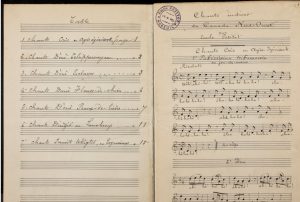CW: Sexual assault/pedophilia
French missionary Father Émile Petitot spent his life researching the Indigenous tribes of Northern Canada. An ordained minister, he was actually never trained as an ethnographer, nor did he study ethnomusicology.1 Petitot traveled from France to stay with the Inuvialuit chief, Noulloumallik Innonarana, where he researched Indigenous music, culture, and languages.2 He lived and worked in Canada until the end of the 19th century.3
Above is an example of Petitot’s transcriptions of Indigenous music, similar to Densmore and other ethnographers of the time who attempted to box this music into Western notation. Since he most likely didn’t have the means to record the songs, it does make sense that he attempted to notate them in a way that can be interpreted later, but it is still a frustratingly white-washed attempt at cultural preservation. Many of the Inuvialuit peoples were extremely mistrustful of Petitot and believed he may be carrying foreign diseases, but he still recorded that they were “hospitable” people.4 Petitot had a fascination with what he called “Eskimos” in Canada and wrote an entire book about them (Le Grands Esquimeuax)FOOTNORE INUV. His obsession with imposing himself and his religion on these people reeks of colonization and exoticization.
His exploitative nature went even darker than this, however, and he took advantage of his position sexually as well. He was said to have had sexual relations with many of the young indigenous people while he was staying with and studying different tribes.5 He had a history of sexually assaulting young people and was fired from a previous church job for having sexual relations with a young boy servant.6 Some records state that he attempted self-circumcision as a means to quell his desires, but he was clearly unsuccessful in his attempts and continued to harm and take advantage of young Indigenous people. He was said to have numerous “bouts of insanity” and mental health issues, and this may be the reason he has many inconsistencies in his research. 7 He had a history of paranoia and once became so paranoid of being murdered by Indigenous tribes that he abandoned all his possessions and ran for it.8 Whatever mental health disorders Petitot may have been suffering with, that is absolutely no excuse for the atrocities he committed. While some of his work may be useful in the world of ethnographic research, his legacy is not one to be praised or celebrated.
1 “Father Émile Petitotback.” Inuvialuit Pitquisiit Inuuniarutait, www.inuvialuitlivinghistory.ca/wiki_pages/Father%20%20%C3%89mile%20Petitot. Accessed 27 Oct. 2023.
3. Lévy, J. (2014). Éros et tabou. sexualité et genre chez amérindiens et les inuit. Recherches Amérindiennes Au Québec, 44(2), 170-174. Retrieved from https://www.proquest.com/scholarly-journals/éros-et-tabou-sexualité-genre-chez-amérindiens/docview/1681918022/se-2
4 “Father Émile Petitotback.” Inuvialuit Pitquisiit Inuuniarutait, www.inuvialuitlivinghistory.ca/wiki_pages/Father%20%20%C3%89mile%20Petitot. Accessed 27 Oct. 2023.
5 Lévy, J. (2014). Éros et tabou. sexualité et genre chez amérindiens et les inuit. Recherches Amérindiennes Au Québec, 44(2), 170-174. Retrieved from https://www.proquest.com/scholarly-journals/éros-et-tabou-sexualité-genre-chez-amérindiens/docview/1681918022/se-2
6 John S. Moir, “PETITOT, ÉMILE,” in Dictionary of Canadian Biography, vol. 14, University of Toronto/Université Laval, 2003–, accessed October 27, 2023, http://www.biographi.ca/en/bio/petitot_emile_14E.html.
7 Honigmann, John J. “Emile Fortuné Stanislas Joseph Petitot Encyclopedia Arctica 15: Biographies.” Dartmouth College Library, collections.dartmouth.edu/arctica-beta/html/EA15-56.html. Accessed 27 Oct. 2023.
8 Ibid.


